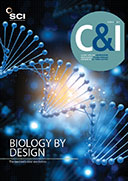‘Today we build things from plastics and polymers and wood and silicon, but one day we could be building them from living cells,’ said Rashid Bashir, professor of bioengineering at the University of Illinois, Urbana-Champaign, speaking at AAAS meeting in Boston in February.
Bashir was speaking at a session on ‘biobots’ – hybrid robots made from synthetic polymers and living cells that promise one day to deliver everything from replacement designer body organs to smart drug delivery devices. Or even self-healing devices that repair themselves when damaged, or intelligent machines equipped with neural networks that think for themselves.
Bashir’s colleague Taher Saif, professor of mechanical science and engineering, made headlines in 2014 with the development of mm long biobot ‘swimmers’ made from living heart muscle cells. In 2015, Bashir and coworkers went on to report the creation of walking ‘biobots’ whose movements can be directed by electrical signals.
Earlier in 2017, Bashir and colleagues now claim to have developed a method to manufacture ‘biological actuators’ – the key component of biobots responsible for switching these biological machines on and off, and for controlling their movements. To make their biological activator, Bashir and colleagues turned to muscle cells, which are a natural ‘actuator’ that converts energy into motion. Early designs of walking biobots, and the swimmers created by Saif, relied on the contraction of beating heart muscle cells as the power source. However, because heart cells pump continuously, they can’t be easily controlled.
The new protocol relies instead on skeletal muscle cells that contract only when triggered, for example by light or electrical signals. How fast the bot moves can then be varied depending on the frequency of the light or electrical pulses.
‘The design is inspired by the muscle-tendon-bone complex found in nature,’ Bashir said. ‘There’s a skeleton or backbone, but made out of soft polymers [hydrogels] similar to the ones used in contact lenses, so it can bend instead of needing joints like the body does.’
To make the biobots, the researchers start by producing a polymer scaffold just 1-2cm in length using a 3D printer. The scaffold is then seeded with muscle cells, whereupon the cells self-organise to form functional tissues that make the biobots move.
‘These machines are now viewed as partially living, with the ability to form, the ability to age and the ability to heal if there's an injury,’ Saif said. In the case of the swimmers, the heart cells were simply thrown together with a length of polymer, he explained, whereupon they aligned themselves in a direction where the ‘tail’ of the swimmer could be bent most: ‘which is exactly what we wanted though we did not pattern or direct them to do it’.
This type of ‘emergent behaviour’ is the key to constructing biological machines, said Melissa Kemp at Georgia Institute of Technology. It describes how cells spread randomly in a system suddenly all switch to a different state – a bit like the way water becomes solid at 0OC.
‘Tissue engineering involves changing cell culture conditions to deliver a desired phenotype,’ said Kemp, whose work involves simulating the growth and differentiation of multicellular systems by computation modelling. ‘Here we’re taking a totally different approach, so can we understand the rules of engagement between cells so we don’t have to go through trial and error to improve the success rate and predict what form and structure the system is going to take.’
‘What we need to do now is to learn the design rules to build with biology,’ Bashir agreed.
Unlike tissue engineering, he explained that biobots also allow the creation of designer structures that don’t currently exist in biology. ‘Tissue engineering tries to replicate what already exists. In this field we want to enhance the natural function or even think about non-natural functions.’ As an example, he pointed out that mammalian blood vessels don’t have pumps; however, it should be straightforward to make them by combining muscle cells with pressure sensing cells.
To date, researchers have confined their studies to just a handful of cell types. However, the goal ultimately is to create biological machines with many different types of cells – including machines with their own vasculature and neurons.
Unsurprisingly, said Lizanne DeStefano, also at Georgia Tech, this type of research poses big ethical questions. While the development of ‘organoids’ for drug testing could be a ‘game-changer’ in animal research, for example, it would require a complete reconsideration of issues surrounding when it is necessary to use animals.
Meanwhile, Bashir noted that his group is already looking at the possibility of creating biobots with a finite lifetime or inbuilt self-destruct mode – based on natural biological cell ageing. The first practical biobot applications are likely to be limited to sensing and cleaning up environmental toxins, and later for delivering drugs or as implantable devices and in medical diagnostics.
The researchers are part of the Center for Emergent Behaviors of Integrated Cellular Systems (EBICS), a $25m initiative of the US National Science Foundation (NSF) aimed at advancing research in complex biological systems.





